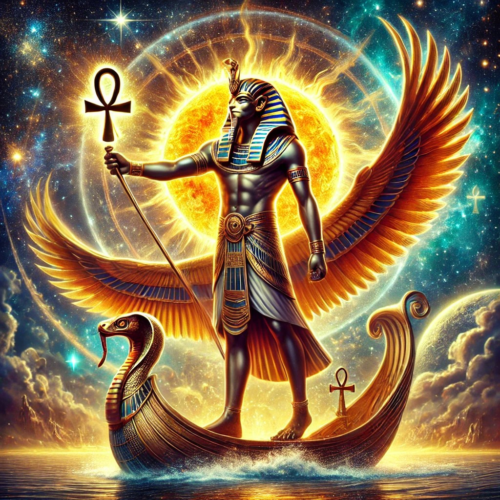Ra, also known as Re, was the ancient Egyptian god of the sun, creation, and cosmic order. As one of the most significant deities in the Egyptian pantheon, Ra was central to the religious and cultural life of the ancient Egyptians. Often depicted as a man with the head of a falcon crowned by a sun disk encircled by a cobra, Ra symbolized the life-giving energy of the sun and the unyielding battle to maintain balance in the universe.
Through his divine will, Ra fathered Shu, the god of air, and Tefnut, the goddess of moisture, who together formed the first divine couple. Their union brought forth Geb, the god of the earth, and Nut, the goddess of the sky, who in turn became the parents of Osiris, Isis, Seth, and Nephthys—some of the most pivotal figures in Egyptian mythology.
The Creator of All Things
According to ancient beliefs, he brought the world into existence by speaking it into being. Emerging from the primordial waters of Nun, Ra was said to have created the first gods, goddesses, and all living beings. His light illuminated the cosmos, making him a symbol of creation, renewal, and the continuity of life.
Ra’s daily journey across the sky in his solar barque represented the cycle of life and death. Every dawn symbolized renewal and creation, while the descent at sunset marked the transition to the afterlife, where Ra would navigate the treacherous underworld to ensure the sun’s rebirth.

Protector of Order
Ra’s role extended beyond creation to the maintenance of Ma’at—universal order and harmony. The sun’s daily journey across the sky was seen as a metaphor for the perpetual struggle between order and chaos. Each night, Ra faced the chaos serpent, Apep, a monstrous being that threatened to consume the sun and plunge the world into darkness. Armed with divine power, Ra’s triumph over Apep ensured the sun’s rise each morning, symbolizing the victory of light over darkness and order over chaos.
Patron of Pharaohs
Ra was intimately connected with the pharaohs, who were considered his earthly manifestations. The title “Son of Ra” was commonly adopted by pharaohs to signify their divine right to rule. In temples and tombs, Ra was often depicted bestowing blessings and protection upon the pharaohs, guiding them through both life and the afterlife. His presence affirmed the pharaoh’s role as a mediator between the gods and humanity.
Symbols and Depictions
Ra was easily recognizable in art and inscriptions due to his distinctive imagery. The sun disk atop his falcon head symbolized his dominion over the sun and its life-giving energy. The cobra encircling the disk represented his power to protect against chaos. He often holds the ankh, the symbol of life, and the was-scepter, a representation of divine authority.
Cultural and Religious Influence
His worshippers gathered most prominently in Heliopolis (Iunu) and honored him as the chief deity. The ancient Egyptians celebrated him through elaborate rituals, hymns, and prayers, invoking his blessings for prosperity, health, and protection. Over time, Ra’s attributes merged with other deities, creating powerful syncretic gods such as Amun-Ra and Atum-Ra, which emphasized his universality.
Legacy of Ra
Ra’s influence extended beyond the borders of Egypt, shaping ancient cosmology and mythology. His archetype as a solar deity inspired other cultures’ interpretations of sun gods and cosmic order. Even today, Ra’s image and mythology continue to captivate modern audiences, symbolizing resilience, renewal, and the eternal struggle for balance.
